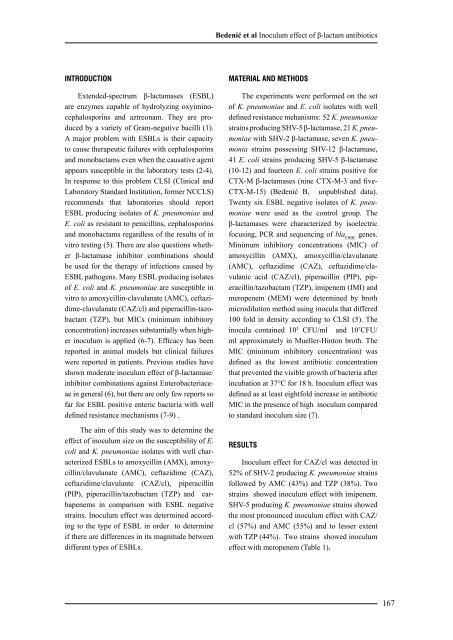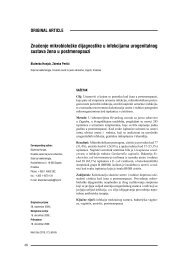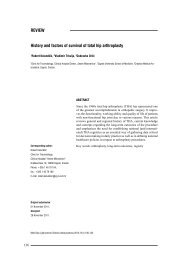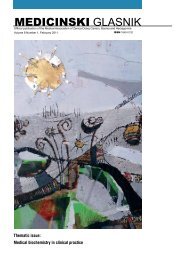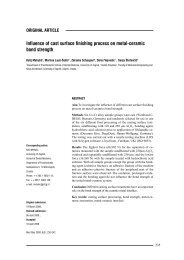MEDICINSKI GLASNIK
MEDICINSKI GLASNIK
MEDICINSKI GLASNIK
You also want an ePaper? Increase the reach of your titles
YUMPU automatically turns print PDFs into web optimized ePapers that Google loves.
INTRODUCTION<br />
Extended-spectrum β-lactamases (ESBL)<br />
are enzymes capable of hydrolyzing oxyiminocephalosporins<br />
and aztreonam. They are produced<br />
by a variety of Gram-negative bacilli (1).<br />
A major problem with ESBLs is their capacity<br />
to cause therapeutic failures with cephalosporins<br />
and monobactams even when the causative agent<br />
appears susceptible in the laboratory tests (2-4).<br />
In response to this problem CLSI (Clinical and<br />
Laboratory Standard Institution, former NCCLS)<br />
recommends that laboratories should report<br />
ESBL producing isolates of K. pneumoniae and<br />
E. coli as resistant to penicillins, cephalosporins<br />
and monobactams regardless of the results of in<br />
vitro testing (5). There are also questions whether<br />
β-lactamase inhibitor combinations should<br />
be used for the therapy of infections caused by<br />
ESBL pathogens. Many ESBL producing isolates<br />
of E. coli and K. pneumoniae are susceptible in<br />
vitro to amoxycillin-clavulanate (AMC), ceftazidime-clavulanate<br />
(CAZ/cl) and piperacillin-tazobactam<br />
(TZP), but MICs (minimum inhibitory<br />
concentration) increases substantially when higher<br />
inoculum is applied (6-7). Efficacy has been<br />
reported in animal models but clinical failures<br />
were reported in patients. Previous studies have<br />
shown moderate inoculum effect of β-lactamase/<br />
inhibitor combinations against Enterobacteriaceae<br />
in general (6), but there are only few reports so<br />
far for ESBL positive enteric bacteria with well<br />
defined resistance mechanisms (7-9) .<br />
The aim of this study was to determine the<br />
effect of inoculum size on the susceptibility of E.<br />
coli and K. pneumoniae isolates with well characterized<br />
ESBLs to amoxycillin (AMX), amoxycillin/clavulanate<br />
(AMC), ceftazidime (CAZ),<br />
ceftazidime/clavulante (CAZ/cl), piperacillin<br />
(PIP), piperacillin/tazobactam (TZP) and carbapenems<br />
in comparison with ESBL negative<br />
strains. Inoculum effect was determined according<br />
to the type of ESBL in order to determine<br />
if there are differences in its magnitude between<br />
different types of ESBLs.<br />
Bedenić et al Inoculum effect of β-lactam antibiotics<br />
MATERIAL AND METHODS<br />
The experiments were performed on the set<br />
of K. pneumoniae and E. coli isolates with well<br />
defined resistance mehanisms: 52 K. pneumoniae<br />
strains producing SHV-5 β-lactamase, 21 K. pneumoniae<br />
with SHV-2 β-lactamase, seven K. pneumonia<br />
strains possessing SHV-12 β-lactamase,<br />
41 E. coli strains producing SHV-5 β-lactamase<br />
(10-12) and fourteen E. coli strains positive for<br />
CTX-M β-lactamases (nine CTX-M-3 and five-<br />
CTX-M-15) (Bedenić B, unpublished data).<br />
Twenty six ESBL negative isolates of K. pneumoniae<br />
were used as the control group. The<br />
β-lactamases were characterized by isoelectric<br />
focusing, PCR and sequencing of bla ESBL genes.<br />
Minimum inhibitory concentrations (MIC) of<br />
amoxycillin (AMX), amoxycillin/clavulanate<br />
(AMC), ceftazidime (CAZ), ceftazidime/clavulanic<br />
acid (CAZ/cl), piperacillin (PIP), piperacillin/tazobactam<br />
(TZP), imipenem (IMI) and<br />
meropenem (MEM) were determined by broth<br />
microdilution method using inocula that differed<br />
100 fold in density according to CLSI (5). The<br />
inocula contained 10 5 CFU/ml and 10 7 CFU/<br />
ml approximately in Mueller-Hinton broth. The<br />
MIC (minimum inhibitory concentration) was<br />
defined as the lowest antibiotic concentration<br />
that prevented the visible growth of bacteria after<br />
incubation at 37°C for 18 h. Inoculum effect was<br />
defined as at least eightfold increase in antibiotic<br />
MIC in the presence of high inoculum compared<br />
to standard inoculum size (7).<br />
RESULTS<br />
Inoculum effect for CAZ/cl was detected in<br />
52% of SHV-2 producing K. pneumoniae strains<br />
followed by AMC (43%) and TZP (38%). Two<br />
strains showed inoculum effect with imipenem.<br />
SHV-5 producing K. pneumoniae strains showed<br />
the most pronounced inoculum effect with CAZ/<br />
cl (57%) and AMC (55%) and to lesser extent<br />
with TZP (44%). Two strains showed inoculum<br />
effect with meropenem (Table 1).<br />
167


